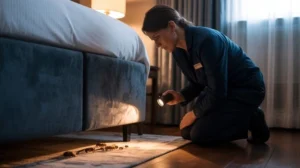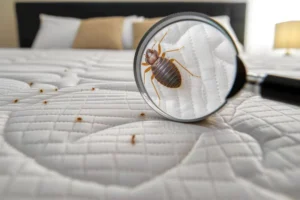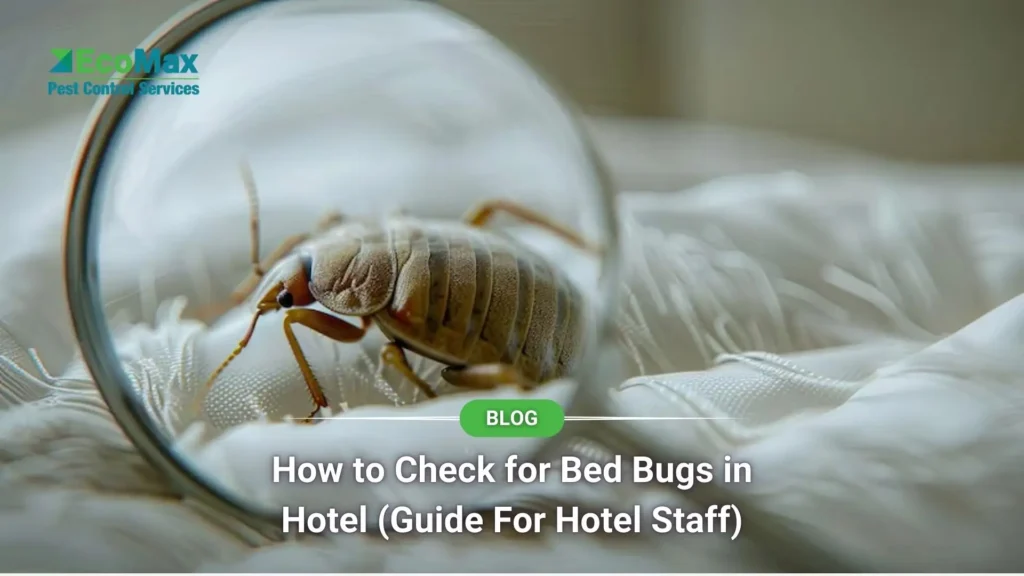When a guest checks into your hotel, they expect comfort, cleanliness, and peace of mind. But even the most well-maintained room can be vulnerable to a hidden nuisance that causes stress and damages your reputation, bed bugs. These tiny intruders can quickly escalate into a major problem if not identified and handled properly.
This guide is crafted for hotel professionals, housekeepers, front desk staff, and property managers, who play a frontline role in keeping rooms guest-ready and pest-free. From how to check for bed bugs in hotel rooms to response protocols and long-term prevention, here’s everything your team needs to know.
What Hotel Staff Should Know About Bed Bugs

Bed bugs (Cimex lectularius) are small, flat, reddish-brown insects that feed on human blood, typically during the night when guests are asleep. They don’t fly or jump, but crawl quickly and are skilled at hiding in tight, dark spaces.
They’re not a sign of poor hygiene or uncleanliness. Even the cleanest hotels can fall victim to bed bugs, especially given the high guest turnover and constant movement of luggage.
Why Bed Bugs Are a Serious Threat to Hotels
- They spread easily from room to room through walls, pipes, and electrical outlets.
- They’re difficult to detect in early stages due to their small size and nocturnal behavior.
- One bad guest review mentioning bed bugs can severely hurt your reputation.
- DIY treatments often fail, allowing the problem to worsen quietly.
Common Areas Where Bed Bugs Hide in Hotel Rooms
Bed bugs tend to stay close to where guests rest or place their belongings. During routine cleaning or inspections, staff should focus on the following zones:
- Mattress seams and folds
- Box springs and bed frames
- Behind mounted headboards and artwork
- Inside dresser drawers and furniture joints
- Upholstered chairs and sofas
- Curtain folds and window drapes
- Luggage racks and closet corners
- Electrical outlets and baseboard gaps
How to Perform a Proper Inspection
Inspections shouldn’t be left to pest control teams alone. Hotel staff, especially housekeeping and maintenance, should be trained to recognize the early signs of bed bugs.
Step 1: Visual Sweep During Room Turnover

Every time a guest checks out, housekeepers should perform a light inspection in key areas. It only takes a few extra minutes and could prevent major expenses later.
Step 2: Use Flashlight Assistance

Bed bugs love shadows. A small flashlight or mobile phone light can help staff check crevices behind headboards, inside furniture, or along floor edges.
Step 3: Check for These Signs

- Live bugs (apple-seed sized and reddish brown)
- Shed skins or tiny white eggs.
- Small black spots (fecal matter) or dried blood stains
- Faint, musty odor in severe infestations
Step 4: Document and Report Immediately

If anything suspicious is found, staff should take photos, note the location, and report it to management right away. Quick documentation is key to fast containment.
How to Check for Bed Bugs in Hotel Rooms
Bed bugs are discreet but not invisible. A trained eye and structured routine can uncover issues before they reach your guests. How to check for bed bugs in hotel rooms requires methodical steps to ensure nothing is overlooked.
Start with the bed, strip the sheets, lift each mattress corner gently, and examine along the seams. Use a flashlight to inspect the box spring and bed frame. Don’t forget to look behind the headboard, especially if it’s mounted on the wall.
Then, examine less obvious places: zippered pillowcases, folds of upholstered furniture, curtain pleats, and the floor area near luggage racks. If any furniture has drawers, check inside and under them. Even electrical outlets and switch plates near the bed can conceal bugs.
If your team performs these checks during every room turnover, it becomes a habit rather than a hassle.
What to Do When Bed Bugs Are Found in a Guest Room
If signs of bed bugs are found, a timely response is crucial. A delay can turn a small problem into a hotel-wide infestation.
- Quarantine the Area
Immediately block the affected room from booking. Also, mark adjacent rooms (above, below, and on both sides) as potentially affected. Bed bugs can travel through internal voids in walls and ceilings. - Relocate the Guest Discreetly
Move the guest to a new room far from the affected zone. Stay professional, apologize, and offer appropriate compensation without using alarming language. - Avoid Moving Infested Items
Do not remove mattresses, bedding, or furniture without proper containment. Moving exposed items can spread bugs to clean rooms or shared areas. - Call Professional Help
Skip the sprays and foggers. These often drive bed bugs deeper into walls and make matters worse. Instead, bring in licensed experts who use heat treatments or targeted chemical solutions. - Follow Up and Monitor
After treatment, continue monitoring the room and adjacent areas weekly for at least 30 days. Even after extermination, vigilance is necessary.
How to check for Bed Bugs in Hotel rooms is crucial for the early detection of these pests. Make sure your staff is trained to spot signs early to prevent further spread.
Eco-Max Pest Control: Your Hotel’s Partner in Reliable Protection
Hotels can’t afford to gamble with pest control. That’s why many hospitality businesses trust Eco-Max Pest Control for responsive and discreet service tailored for the industry.
We specialize in Bed Bug Control Services that are safe for both staff and guests. Our treatments are effective, eco-conscious, and minimally disruptive.
Our Hotel-Specific Services Include:
- Heat treatments that kill all stages of bed bugs in a single visit
- Eco-safe, non-toxic methods for guest and staff safety
- Discreet service appointments to avoid drawing attention
- Preventive inspections and on-site staff training
- Detailed reports and follow-up monitoring for peace of mind
Whether you manage a boutique hotel, a chain property, or a short-stay rental, Eco-Max is ready to help you stay ahead of infestations.
Final Thoughts: Awareness is the First Line of Defense
Bed bugs don’t care about star ratings or cleaning checklists. But what they do respond to is awareness, routine inspection, and swift action.
By training your team to understand how to check for bed bugs in hotel rooms, you’re not just protecting your guests, you’re protecting your brand, your bookings, and your bottom line.
Partnering with experienced pest control providers and promoting a culture of proactive inspection can ensure your hotel stays pest-free and guest-ready.

